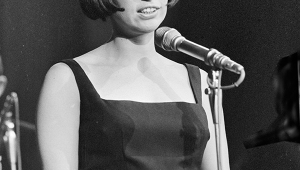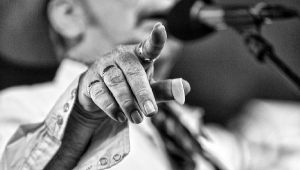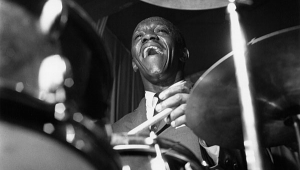| Columns Retired Columns & Blogs |
The Bob Dylan Bootleg Series Page 3
Well, Dylan seems to have saved most of his for the '70s and '80s---throughout the '60s, he was inevitably on. The Bootleg Series bears this out: 36 of the 58 tracks cover a mere six years, 1961-67; Vol.1 covers only 1961-63. It's indicative of Dylan's incredible creativity during this time that, during his three-year publishing contract with Witmark (1962-65), he logged 237 compositions. Nor were these endless revisions of the same three basic folk songs. What The Bootleg Series overwhelmingly showcases is Dylan's incredible variety---of vocal styles, song structure, lyric style, melodies, arrangements. The set documents, once and for all, many crucial things about Dylan's art: his astonishing creativity as a composer---something about which he's received much bad press---and not merely as an inspired poet setting his verse to recycled journeyman tunes; that the man is a world-class singer, so singular in talent and style---more a vocal actor---that the usual criteria simply don't apply; that all the hype, the mythology, the legends, were, incredibly, justified; and that, at least as late as 1983 and "Blind Willie McTell," the man's feet---of clay or flesh---still filled those seven-league boots.
In short, for anyone who ever took Dylan seriously as poet, songwriter, avatar, hero, inspiration, singer, visionary, folkie, rocker, Jew, Christian, or the ultimate pre-punk progenitor of hipster cool, this set is absolutely essential listening. You simply must hear it.
The large numbers of outtakes from Dylan's first two albums---two from Bob Dylan, no less than eight from Freewheelin'---bear witness to his richly varied repertoire of the time. From the weary, understated elegy of "He Was A Friend of Mine" to the chilling, masterful performance and rewrite---and great guitar picking, from a time when Dylan still cared about such things---of the Child Ballad "House Carpenter," Dylan, who was only 20 or 21 when these recordings were made, displays a sensitivity, confidence, and maturity too convincing to have been faked. Where could he have learned to sing like this? His performance of "House Carpenter" is the best I've heard of this favorite folkie chestnut.
"Let Me Die In My Footsteps," a strong protest song about the Civil Defense bomb-shelter craze of the late '50s and early '60s, was included on early promotional pressings of Freewheelin' but was dropped, among others included here, to make room for "Hard Rain" and "Bob Dylan's Dream." Also recorded for Freewheelin' but unreleased until now are two talking blues, "Bear Mountain Picnic Massacre" and "Hava Negeilah." Dylan's comic timing is well-nigh perfect on the former, heavy-handed on the latter; they were replaced by the more politically pointed "Talkin' World War III" on Freewheelin'. "Kingsport Town" is a gentle gem based on "Who's Gonna Shoe Your Pretty Little Feet?" (but who's playing that second guitar...?).
Also from this time is a tape of "No More Auction Block," an old spiritual recorded live at Greenwich Village's Gaslight. Odetta's influence on Dylan's guitar and vocal styles is obvious here; Dylan has admitted that "Blowin' in the Wind" was based on this sad, weary song sung by a slave who's won his freedom.
Outtakes from The Times They Are A'Changin' reveal someone's decision to make that album consist entirely of Dylan originals. "Moonshiner" and "Seven Curses" are more or less traditional tunes tightened and pointed by Dylan in ways that remain wholly his own: no other member of the folk movement ever seemed able to so totally surround, ingest, and rebirth a song as Dylan almost always did (and still does: listen to his acoustic "Pretty Boy Floyd" on A Vision Shared). The piano version of "Paths of Victory" sounds even more Woody Guthrie-esque than the guitar version on Biograph, while "Only a Hobo" has added meaning in this era of increasing homelessness. "Eternal Circle" is a clever, little-known Dylan composition about a singer's eye being caught by a pretty girl in the front row whose interest is more in the song than the singer. And there are alternate, slower takes of "When the Ship Comes In" and "The Times They Are A'Changin'"---on piano.
Interspersed among these are selections from Bob Dylan Live at Carnegie Hall, an album recorded but scrapped. The concert has been widely bootlegged, and excerpts found their way onto Greatest Hits Vol.II and Biograph. This third installment includes "Talkin' John Birch Paranoid Blues," a funny, pointed satire of the Red Scare; "Who Killed Davey Moore?," a classic Dylan indictment of professional boxing, whose shout-along chorus of "WHO KILLED DAY-vey MOORE? WHY and WHAT'S the REA-son FOR?" simply demands audience participation; and what is probably the centerpiece of the entire collection, "Last Thoughts on Woody Guthrie."
"Last Thoughts" is a long poem by Dylan, and the only known instance of his reading his own poetry---or prose---in public. It's a rant read without anger, an expansive outpouring in the generous traditions of Ginsberg and Whitman, rushed through as though Dylan simply couldn't get it out fast enough. A mix of doggerel and pure inspiration, forced rhymes and startling associations, this self-portrait mentions Woody Guthrie only in the last few lines, when the "you" of the poem (Dylan himself) is faced with seeking God in the church of his choice or Woody Guthrie in Brooklyn State Hospital, and ends up finding both at sundown in the Grand Canyon. "Last Thoughts," more than any other track on this entire set, reveals why The Bootleg Series eventually had to be released: Dylan's incredible, irrepressible creativity that could not be contained by the release schedules of the past. In this poem, he explains just why he had to do all that followed, and where it all came from. Back in April 1963, Bobby Dylan still sounded like a midwestern boy/man with roots deep in the center of America's heart, back when the country had such a thing; in "Last Thoughts," he stood poised to shoot up and out in all directions at once, secure in the knowledge that he knew where he'd been and where he'd come from, spiritually, geographically, musically. And that's just what he did, as Discs Two and Three make more than clear.
- Log in or register to post comments



































